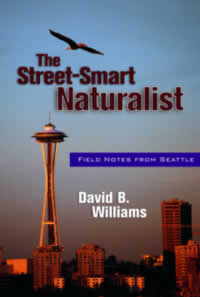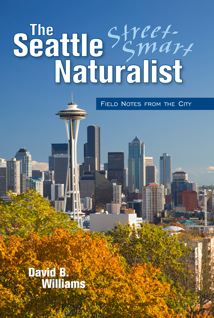The Seattle
Street-Smart Naturalist:
Field Notes from the City
(new title, same great book)
The
Street-Smart Naturalist:
Field Notes from Seattle
224 pages, 6 x 9", B/W maps, $14.95
Published by WestWinds Press, an imprint of Graphic Arts Center
Publishing
ISBN: 1-55868-859-5
Bird-watchers, bicyclists, organic gardeners,
rock hounds, tree huggers, weather nuts, history buffs, community activists
and downtown
office workers — that covers just about everybody in Seattle, doesn't
it? — will find plenty to embrace in "The Street-Smart Naturalist:
Field Notes from Seattle," an inviting new book by David B. Williams
Barbara Lloyd McMichael
Seattle
Times review - June 10, 2005
Even if you are not familiar with Seattle
-- I've been there for one relatively brief visit, so I'm definitely
in that category -- there is plenty to relate to in this book...Williams'
essays demonstrate that a keen eye is as useful as an unlimited travel
budget in studying the natural world.
Tom Palmer
The
Ledger review - Lakeland,
Florida September 8, 2005
A passion for nature and the love of a chosen city combine seamlessly
in David Williams' sharp-eyed rambles through Seattle. These beautifully
told field notes of this inspired urban naturalist bring to life our
streets and hills, our downtown edifices, and suburban green pockets
on levels infinitely more profound than the every day.
Ivan Doig
Author of This House of Sky and Prairie
Nocturne
Reading David Williams' The Street-Smart Naturalist is like suddenly
acquiring x-ray vision, supernaturally acute hearing, a synapse-clearing
sense of smell - and the expertise to process this rush of new data.
Who knew that there was so much fascinating natural history crawling,
flying, sprouting, flowing, drizzling, cawing, accreting and sliding
within the city limits of Seattle? Every page, every paragraph of Williams'
book brought me revelations - not to mention the sheer pleasure of
keeping company with such a sharp and enthusiastic writer. I can't think
of a
better guide to what's really going on - and has been going on for
millennia - in our fair city.
David Laskin
Author of The Children's Blizzard and Rains all the Time
A few thoughts about the book
I began work on this book soon after my wife, Marjorie, and I
moved to Seattle in 1998. I did not have any preplanned ideas when I
began work. I simply wanted to focus on the natural world in Seattle.
In some essays I explored by foot or bike. In others I chose a topic
and
delved
deeply into it, interviewing experts, probing its history, and going
out into the field with scientists. A few of them focus on topics that
have long interested me, such as building stone or weather, and others
arose because they simply seemed fascinating at the time. I enjoyed
writing and researching each of them. I also know that I like Seattle
better
after spending so much time exploring and discovering new and old places.
What these stories and my adventures in Seattle confirm for me is that
you don't have to go to exotic places to find interesting natural history
stories, despite what you might see on the Discovery Channel or in
the pages of National Geographic.
These fine purveyors of nature leave you
with the distinct feeling that nature is out there, away from most
people's ordinary lives. They fail to show that stories are in our
yards, under
our feet, and on the walls of our buildings. Stories and nature are
all around us, if we take the time to look and wonder.
I am not saying that we should substitute urban experiences for wild
ones, but I recognize that most urban dwellers stand a better chance
of developing a relationship with a goose than with a gorilla. We will
develop connections with nature more often in our neighborhood parks
than in national parks. We will have our first childhood encounter
with a wild, undomesticated animal while exploring our backyards or
nearby
green spaces. These encounters and experiences will become more important
as we continue to become a more urban planet.
Getting to know the urban wild will also influence how we react in
wilder places. What lessons will people learn when they see public
officials
killing Canada geese in Seattle? What if instead citizens heard public
officials challenging us to make changes in order to coexist with thousands
of geese? I cannot help thinking that positive experiences with wildness
in urban settings will lead to a positive land ethic in wilder places.
To give a better idea of what The Street-Smart
Naturalist is about here is an outline of
the chapters.
Chapter 1 - The Eagles: For the first
time in recent history, a pair of bald eagles nested at Seattle's busiest
park, Green Lake. In 1998,
I watched them build their nest, catch fish in the lake, and feed their
youngster. We are fortunate that a dozen pairs of eagles nest in the
city, but can modern day residents pat ourselves on the back for this
situation. Along with describing a year in the life of the birds, I
also look at what led to the return of bald eagles from the brink of
extinction
and whether our actions will drive them away.
Chapter 2 - The Fault: Unlike people
in most regions of the country, Seattle's citizens are constantly reminded
of the area's geologic past,
present, and future. Seldom was this more clear than on February 28,
2001, when a magnitude 6.8 earthquake rippled through the city. While
dramatic, this was not the Big One that
so concerns geologists, who worry more about a sizable break in the
Earth's crust that runs right
through
downtown Seattle. What is the regional geology and how does the Seattle
Fault zone affect urban dwellers? Does Seattle rival California as
the place not to be when the Big One hits?
Chapter 3 - The Plants: If you asked
early citizens of Seattle which natural feature best symbolized the
region, few would have hesitated
in responding "Douglas firs." These trees were everywhere,
but they were not the only plants in the area. I describe
the presettlement botanical landscape of Seattle by examining modern
clues,
such as neighborhood names, big stumps, or big trees, that provide
hints for telling this story and for showing the complexity and beauty
of Seattle
150 years ago.
**A modified excerpt of chapter 3 appeared in The Seattle Weekly, February
16th.
Chapter 4 - The Creek: With a watershed
of nearly 12 square miles, Thornton Creek drains more ground than any
other in the city. Over the last several
years, local citizens, schools, and public agencies have radically
altered the creek by removing trash and alien species, replanting native
species,
and constructing a nine-acre pond, home for salmon, birds, and beaver.
Thornton is also the center of a fight over a little-used parking lot
that covers the creek. Should the space become a high density development
or should the lot be ripped up to provide more salmon habitat, and
at what cost? Via a walk down the length of the creek I address
the natural
and political history of Thornton Creek.
Chapter 5 - The Stone: Most people
do not think of looking for geology from the sidewalks of a major city,
but for the intrepid geologist any
good rock can tell a fascinating story. In Seattle, for instance, one
can see a range of rocks equal to any assembled by plate tectonics.
Through a walking tour of building stone used in downtown Seattle buildings,
I tell stories in stone that touch on politics, the geologic record,
and local history.
Chapter 6 - The Geese: Forty years
ago, sighting a Canada goose would have caused most Seattle residents
to stop and stare at this handsome
symbol of wildness. Now, many city dwellers just wish this magnificent
bird and its poop would go away. I look at the historic plan to
introduce in Canada geese into new habitats, dubbed Operation
Mother Goose, to illustrate how we manipulate urban wildlife
and then complain about the
problems
we
created.
**
A modified excerpt of this chapter appeared in the Seattle
Times Pacific Northwest Magazine, Sunday, July
17, 2005.
Chapter 7 - The Bugs: We are
not alone. A typical pinch of backyard soil contains close to a billion
living organisms, and bugs as diverse as jumping spiders, daddy longlegs,
potato bugs, earwigs, beetles, weevils, cockroaches, butterflies, moths,
aphids, houseflies, and mealybugs live in and around our houses. With
whom do we share our homes, what interesting stories do they have to
tell, and why do my eight-year-old nephews and other kids love six-
and eight-legged beasties while adults usually dislike these generally
beneficial
critters?
Chapter 8 - The Weather: Sunshine
in Seattle is a funny thing. Locals go nuts. Visitors are surprised.
All of us do things we shouldn't. What
creates such behavior. How does weather affect us? Where does it come
from and why have we been defensive about the rain for over 100 years?
I address these questions and more in a examination of the our legendary
climate.
Chapter 9 - The Hills: "Like Rome, Seattle was built on seven hills," or
so say guidebooks and locals. It certainly sounds good, considering the
number of clutches burned out while trying to negotiate the steep slopes,
but is it true that Seattle shares this geographic anomaly with the original
home of the double latté? I examine Seattle's glacial past
via a single day ascent of the fabled seven and look at how local geology
influences Seattleites on a daily basis.
Chapter 10 - The Invaders: Pigeons,
rats, starlings, dandelions, and blackberries are some of the most
obvious species that have invaded Seattle
since Europeans arrived. While many lead intriguing lives (Darwin was
a big pigeon fan), they also negatively affect natives. When were these
species introduced and by whom? In exploring the natural history of
alien species, I also delve into issues of conservation in Seattle.
**An edited edition of chapter 10 appears in Open
Spaces magazine,
Spring 2005, Volume 7, Number 3.
Chapter 11 - The Water: Turn on a
tap in Seattle and out flows some of the purest water in the country,
thanks
in part to a decision made in 1889 to purchase the Cedar River Watershed.
Flush a toilet and material is whisked away to a modern sewage treatment
system, but this has not always been the case. I trace water from
forest to faucet and sink to Sound, along the way exploring the history
of the watershed and sewer treatment system (our first sewer was built
in 1865 and consisted of wood troughs).
Chapter 12 - The Crows: Most people
have not had seven crows wrapped in used socks lying in the back of
their car. I have had this privilege,
while assisting University of Washington graduate student John Withey
during his study of urban crows. We had caught the birds to band them
so that John could find out why Seattle's crow population has grown
exponentially over the last 20 years. This story describes John's
research, the
natural history of crows, and past people/crow interactions in Seattle.

